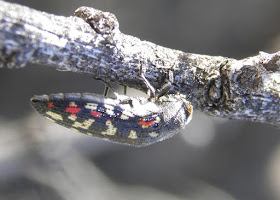Lower Sabino Canyon, so safe and easy to walk but usually too busy with visitors, changes character at night. A little more wilderness, a lot more mystery. Very few people. The air seems to vibrate with cricket and katydid sounds and some that are tantalizingly close and distinct like the solo of a percussion instrument in a jazz band, but unrecognizable - at least to my companion, reptile photographer Rene Clark, and me.
 |
| Migrating (?) Canyon Wrens were tucked under the eaves of all bath room buildings |
 |
| Crevice Spiders, Giant Crab Spiders, Flatties and Black Widows in abundance |
After dark, our observations began quite low key and prosaic with numerous visits to the little bath room buildings that dot the canyon. The wall of these Roosevelt-Civilian-Conservation-Corps-style buildings are made of natural stone and provide shade, niches and crevices for paper wasp nests, interesting spiders, Canyon Tree Frogs, and sleeping Canyon Wrens.
 |
| A camel cricket crossing the road |
Further up the canyon the creek was running, sounding fresh but smelling a little foul in places. Clear enough though to see Sunburst Beetles diving and Whirligig Beetles dancing in the beam of our lights.
On shear rock walls we looked for Amplygids (Tailless Whip Scorpions) but found only a very nice tarantula.
Ghostly pale beauties, Datura flowers lured me into the riparian underbrush. But it was the lowly Ragweed that bore interesting insects: the fecal-shield protected larva and the Halloween-masked adult form of the big tortoise beetle
Physonota arizonae
At night, the nose can become become more important than the eyes. I never realized the fresh, fruity smell of blooming Brickell Bush and until now, and I had only smelled Desert Lavender after I crushed the leaves. Yellow asteraceae along the water exuded a potent tagetes smell that instantly conjured up my mother's garden's marigold borders. Most of the active responders were nectaring moths.
The Desert Broom also had a faint, pleasant smell that I noticed for the first time. Surprisingly, this time it did not make me sneeze. A rather mixed community here, even a canyon frog that remenbered its phylogenetic roots among the tree frogs
We also found many paper wasps of at least 3 species. They nearly all turned out to be sleeping males that drowsily, but harmlessly crawled towards the cameras and onto our sleeves.
Other insects relied on the
warning the olfactory sense can provide: disturbed Pinacate Beetles interrupted their wandering and to stick their hind end into the air and when that wasn't enough to deter my probing finger I got doused with a staining, stinking gush of hydroquinons.
After renewing that experience I did not even try to interrupt the hurried pass of a Chlaenius ground beetle because I like their stench even less. And there was always the resident skunk rustling in the brush near by ...
 |
| Smerinthus saliceti |
Rather save from that night prowler, big sphingid caterpillars were stripping leaves from the riparian trees. I usually leave caterpillar expertise to expert friends like Dave Wagner. But one big cat was chomping on Ash, the smaller hornworm devoured Willow leaves. Though similarity to Rustic Sphinx on honeysuckle was noted, it was clear that these hosts would to entertain a different crowd. So knowing the family - Sphingidae, with horned 'worms', and the plant association made it easy to confirm my suggestion: the caterpillar on willow belonged to the eyed Sphinx
Smerinthus saliceti and the larger one on ash was
Sphinx chersis, the Great Ash Sphinx.
 |
| Sphinx chersis, the Great Ash Sphinx |
Without noticing, we had covered nearly the entire length of the canyon. When we turned back, Great Horned Owls were hooting and a single firefly blinked in the canopy. We thought it might have been to late in the season for Poorwills that we usually hear at night.
 |
| Just then my camera died |
On the way back down we walked faster and did not plan on stopping a lot, when the Hooded Skunk marched into the road right in front of us. Amazingly, on the light tarmac, his long flowing white mane made him next to invisible in the moon light, a ghostly appearance that had us transfixed, except that our hands were frantically searching the right button on our cameras. He came directly towards us, very close. Alas, my camera's battery failed right when he was in reach of our macro lenses and Rene also mumbled something very disappointed. And after being flashed at once, he had had it and strolled off. Most amazing? None of us thought about being sprayed at that moment.
The rest of the way was uneventful but good exercise. To tired to ponder why the mantis crossed the road. Home by midnight. A night well-spent.

























































